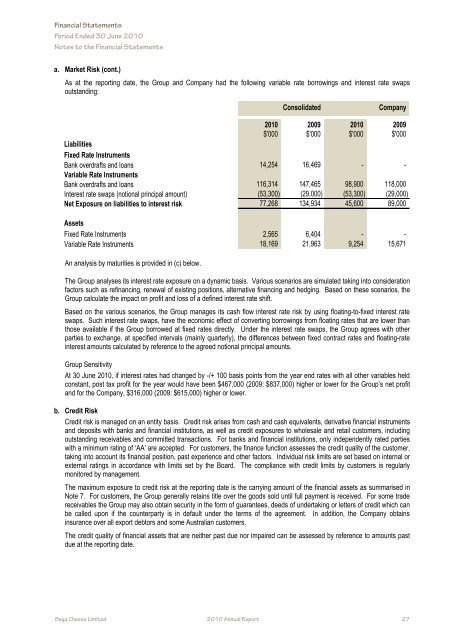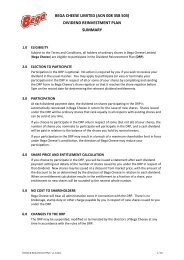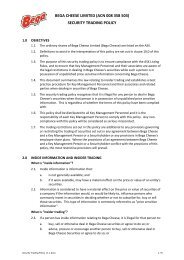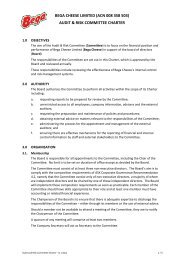Annual Report - Bega Cheese
Annual Report - Bega Cheese
Annual Report - Bega Cheese
Create successful ePaper yourself
Turn your PDF publications into a flip-book with our unique Google optimized e-Paper software.
Financial Statements<br />
Financial Period Ended Statements 30 June 2010<br />
Period Notes to Ended the Financial 30 June 2010 Statements<br />
Notes to the Financial Statements<br />
a. Market Risk (cont.)<br />
As at the reporting date, the Group and Company had the following variable rate borrowings and interest rate swaps<br />
outstanding:<br />
Consolidated<br />
Company<br />
2010 2009 2010 2009<br />
$'000 $'000 $'000 $'000<br />
Liabilities<br />
Fixed Rate Instruments<br />
Bank overdrafts and loans 14,254 16,469 - -<br />
Variable Rate Instruments<br />
Bank overdrafts and loans 116,314 147,465 98,900 118,000<br />
Interest rate swaps (notional principal amount) (53,300) (29,000) (53,300) (29,000)<br />
Net Exposure on liabilities to interest risk 77,268 134,934 45,600 89,000<br />
Assets<br />
Fixed Rate Instruments 2,565 6,404 - -<br />
Variable Rate Instruments 18,169 21,963 9,254 15,671<br />
An analysis by maturities is provided in (c) below.<br />
The Group analyses its interest rate exposure on a dynamic basis. Various scenarios are simulated taking into consideration<br />
factors such as refinancing, renewal of existing positions, alternative financing and hedging. Based on these scenarios, the<br />
Group calculate the impact on profit and loss of a defined interest rate shift.<br />
Based on the various scenarios, the Group manages its cash flow interest rate risk by using floating-to-fixed interest rate<br />
swaps. Such interest rate swaps, have the economic effect of converting borrowings from floating rates that are lower than<br />
those available if the Group borrowed at fixed rates directly. Under the interest rate swaps, the Group agrees with other<br />
parties to exchange, at specified intervals (mainly quarterly), the differences between fixed contract rates and floating-rate<br />
interest amounts calculated by reference to the agreed notional principal amounts.<br />
Group Sensitivity<br />
At 30 June 2010, if interest rates had changed by -/+ 100 basis points from the year end rates with all other variables held<br />
constant, post tax profit for the year would have been $467,000 (2009: $837,000) higher or lower for the Group’s net profit<br />
and for the Company, $316,000 (2009: $615,000) higher or lower.<br />
b. Credit Risk<br />
Credit risk is managed on an entity basis. Credit risk arises from cash and cash equivalents, derivative financial instruments<br />
and deposits with banks and financial institutions, as well as credit exposures to wholesale and retail customers, including<br />
outstanding receivables and committed transactions. For banks and financial institutions, only independently rated parties<br />
with a minimum rating of ‘AA’ are accepted. For customers, the finance function assesses the credit quality of the customer,<br />
taking into account its financial position, past experience and other factors. Individual risk limits are set based on internal or<br />
external ratings in accordance with limits set by the Board. The compliance with credit limits by customers is regularly<br />
monitored by management.<br />
The maximum exposure to credit risk at the reporting date is the carrying amount of the financial assets as summarised in<br />
Note 7. For customers, the Group generally retains title over the goods sold until full payment is received. For some trade<br />
receivables the Group may also obtain security in the form of guarantees, deeds of undertaking or letters of credit which can<br />
be called upon if the counterparty is in default under the terms of the agreement. In addition, the Company obtains<br />
insurance over all export debtors and some Australian customers.<br />
The credit quality of financial assets that are neither past due nor impaired can be assessed by reference to amounts past<br />
due at the reporting date.<br />
<strong>Bega</strong> <strong>Cheese</strong> Limited 2010 <strong>Annual</strong> <strong>Report</strong> 27<br />
<strong>Bega</strong> <strong>Cheese</strong> Limited 2010 <strong>Annual</strong> <strong>Report</strong> 27












